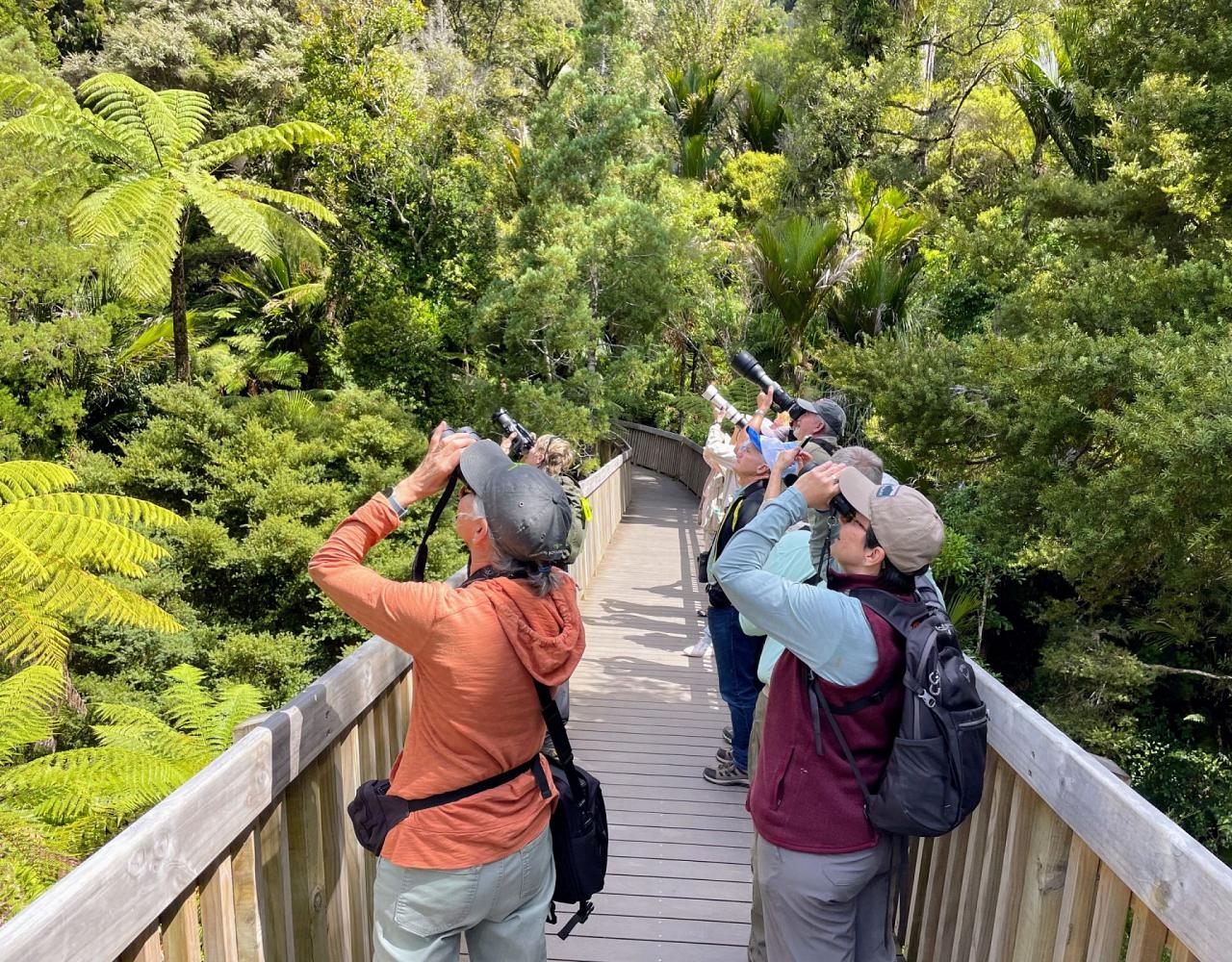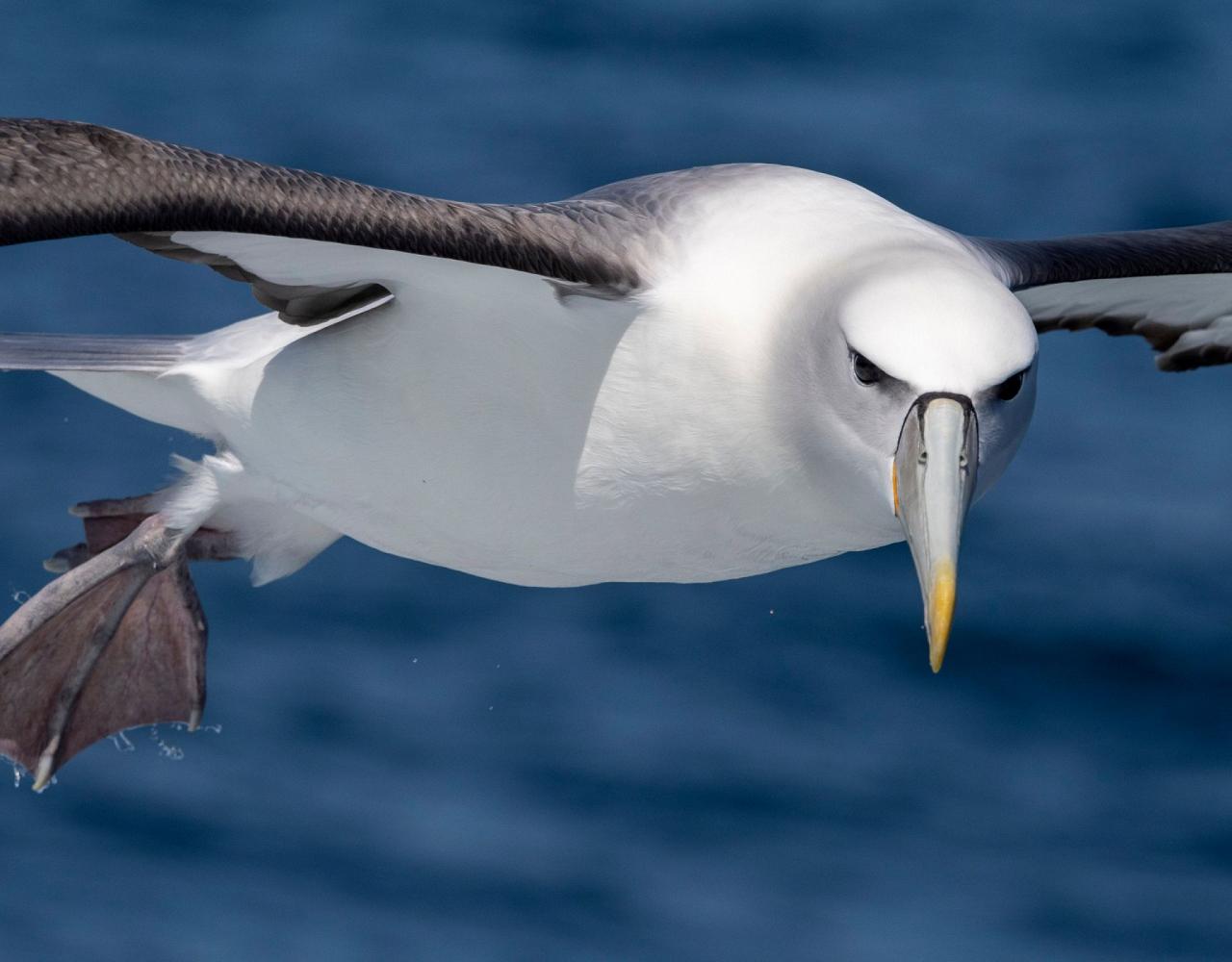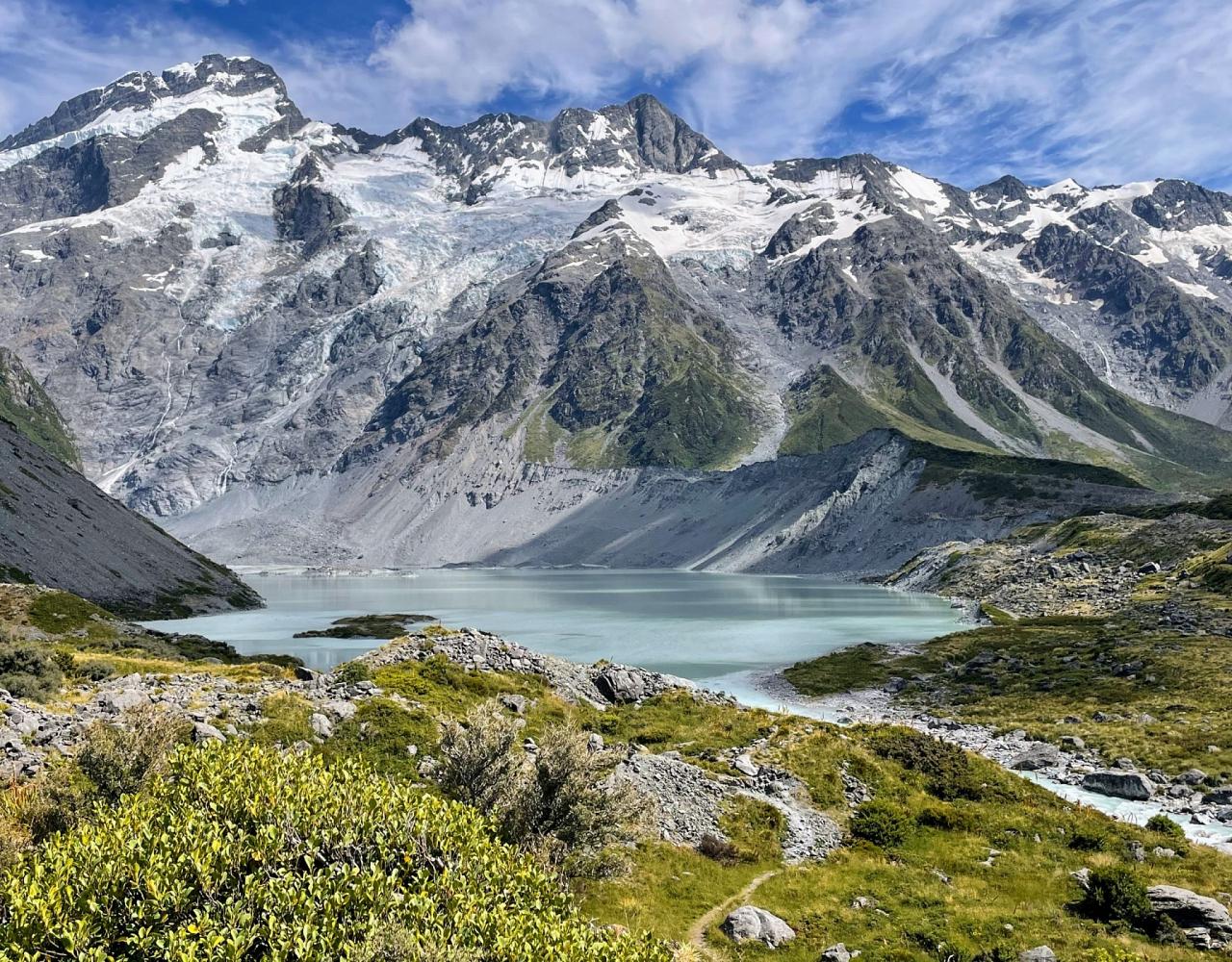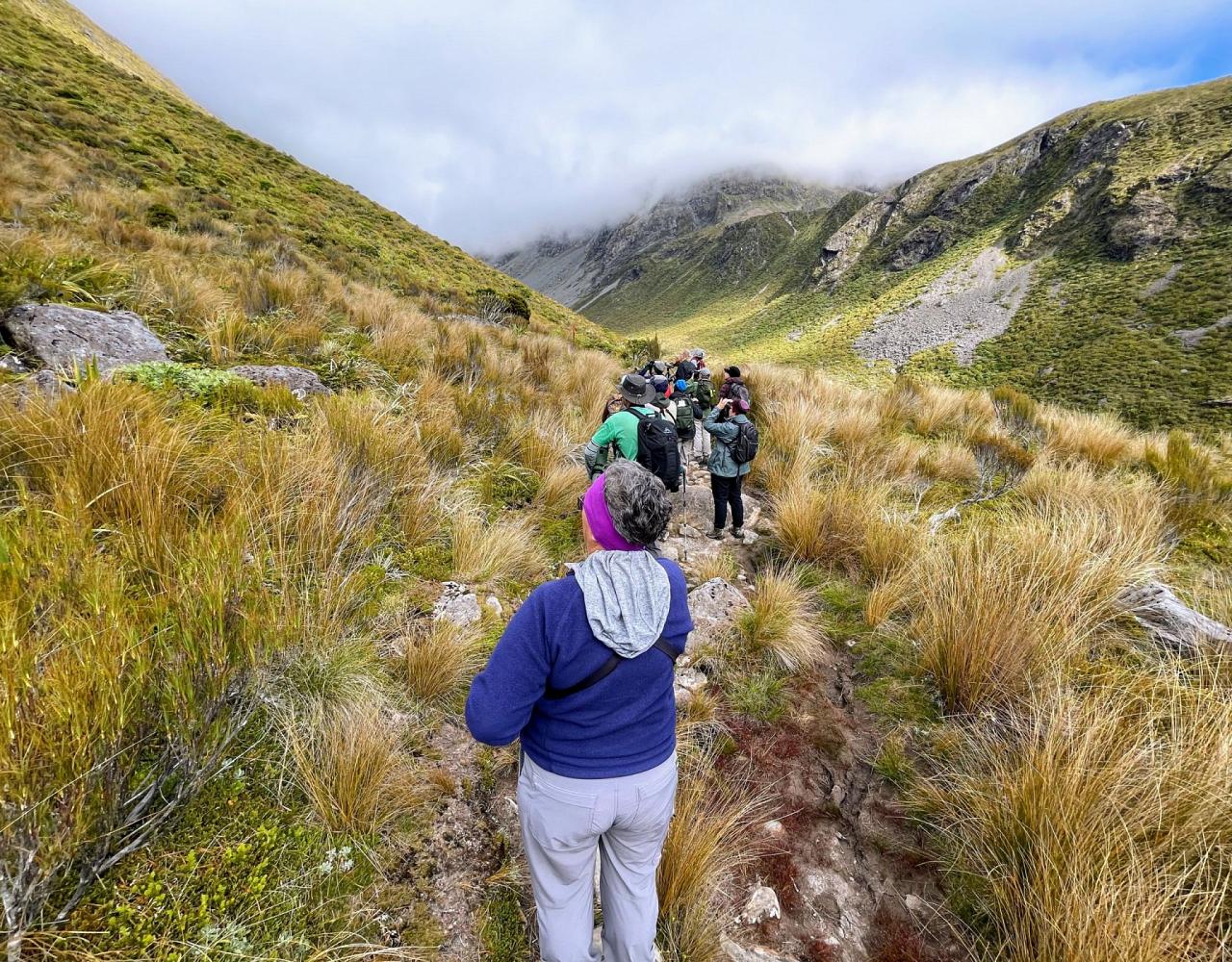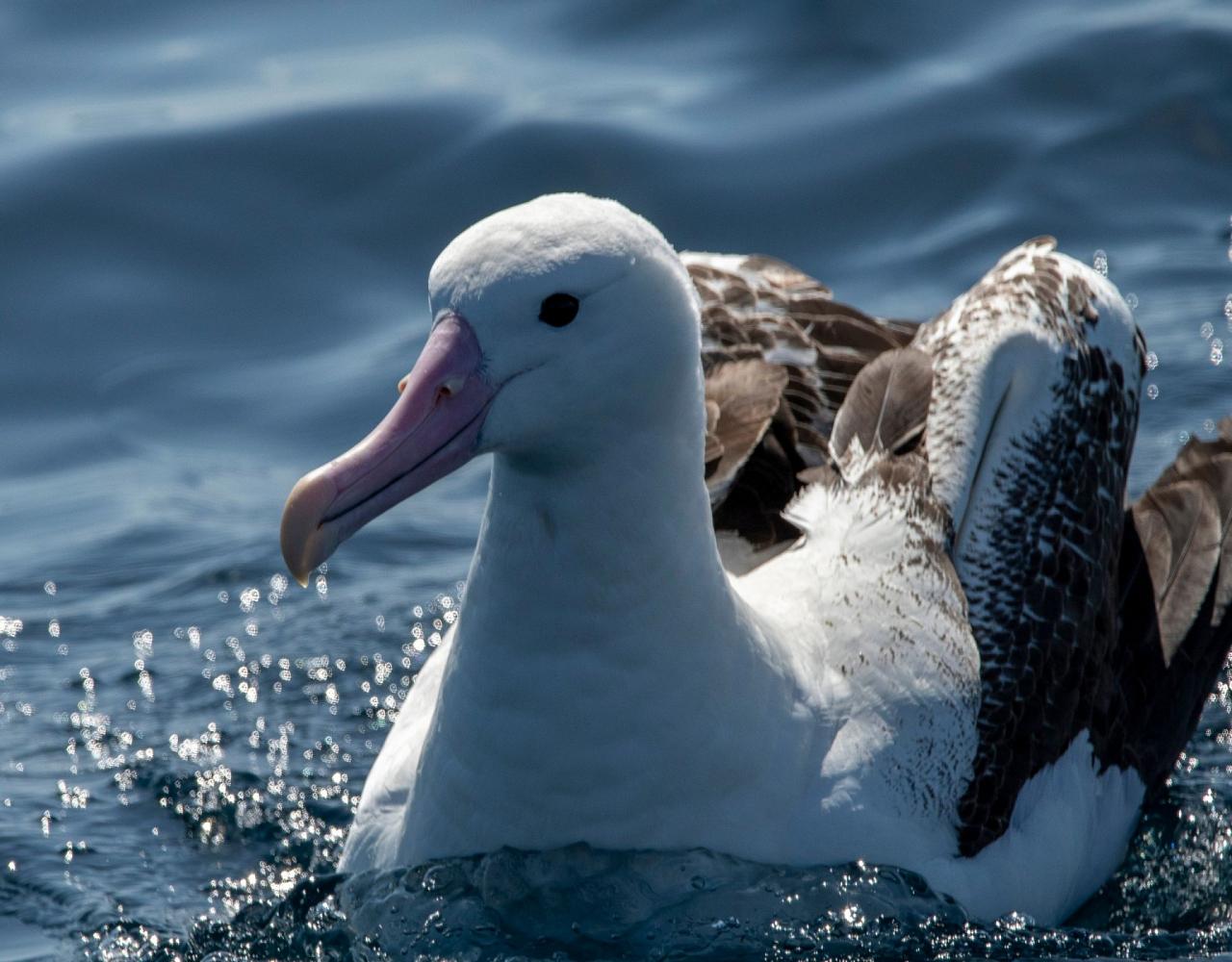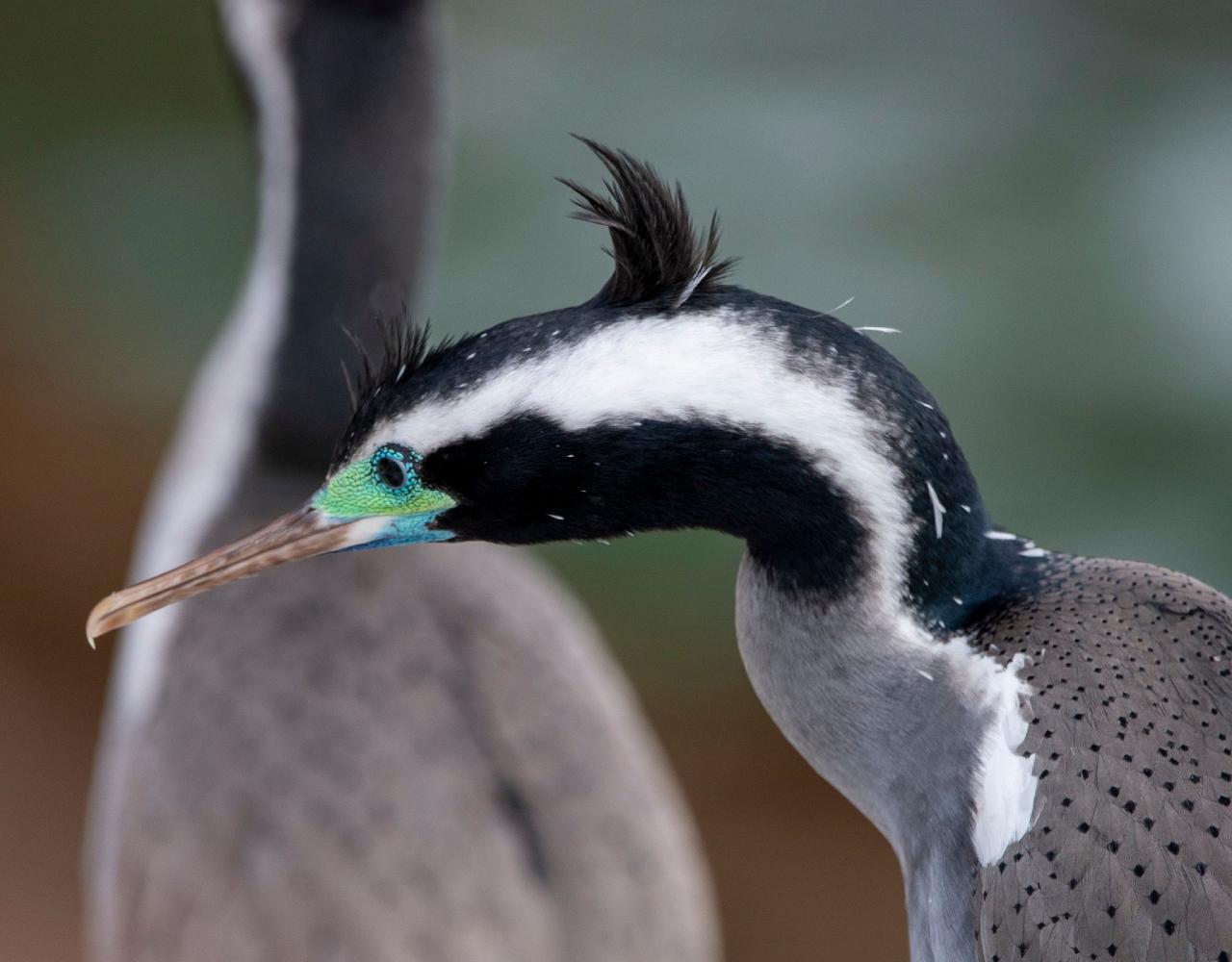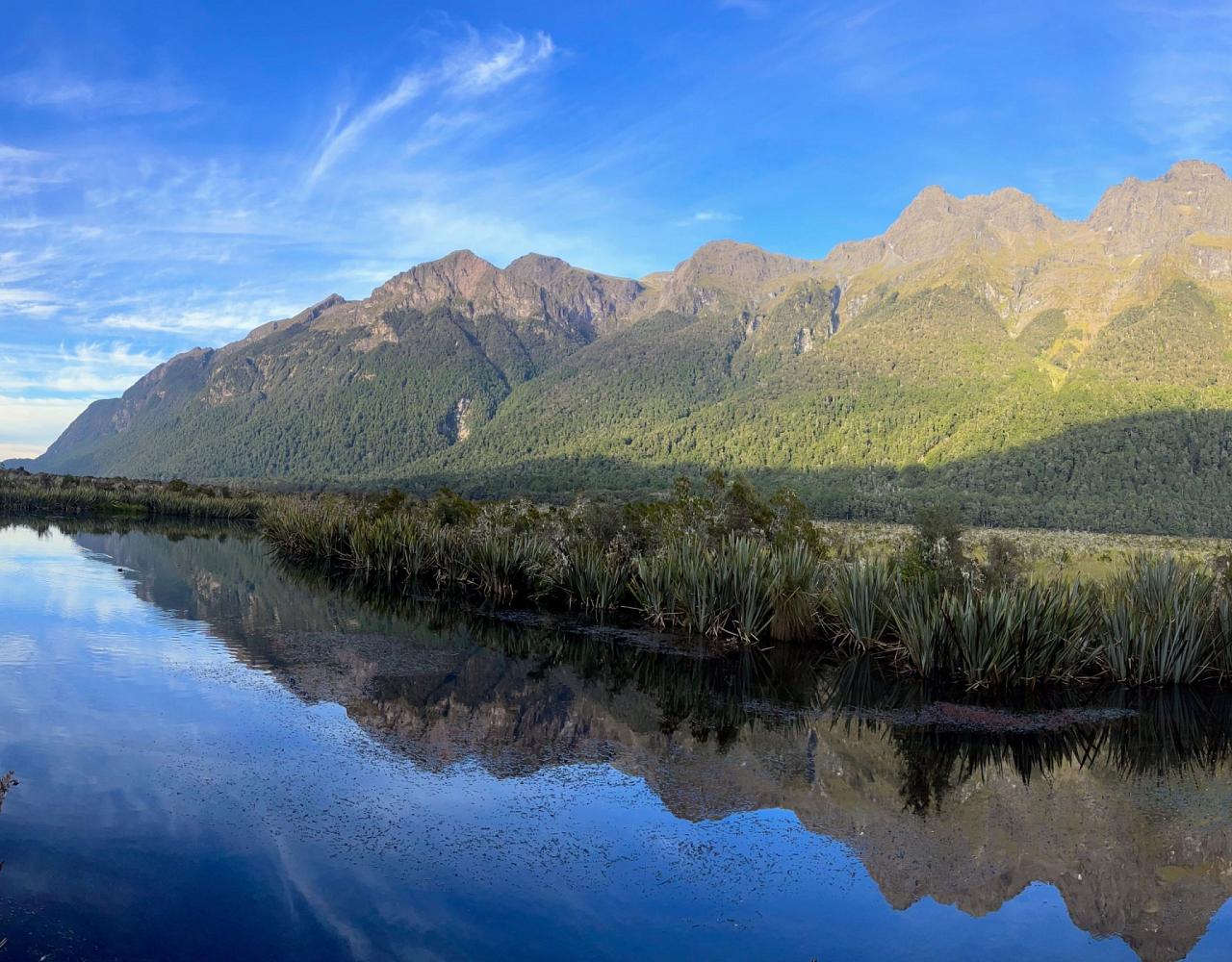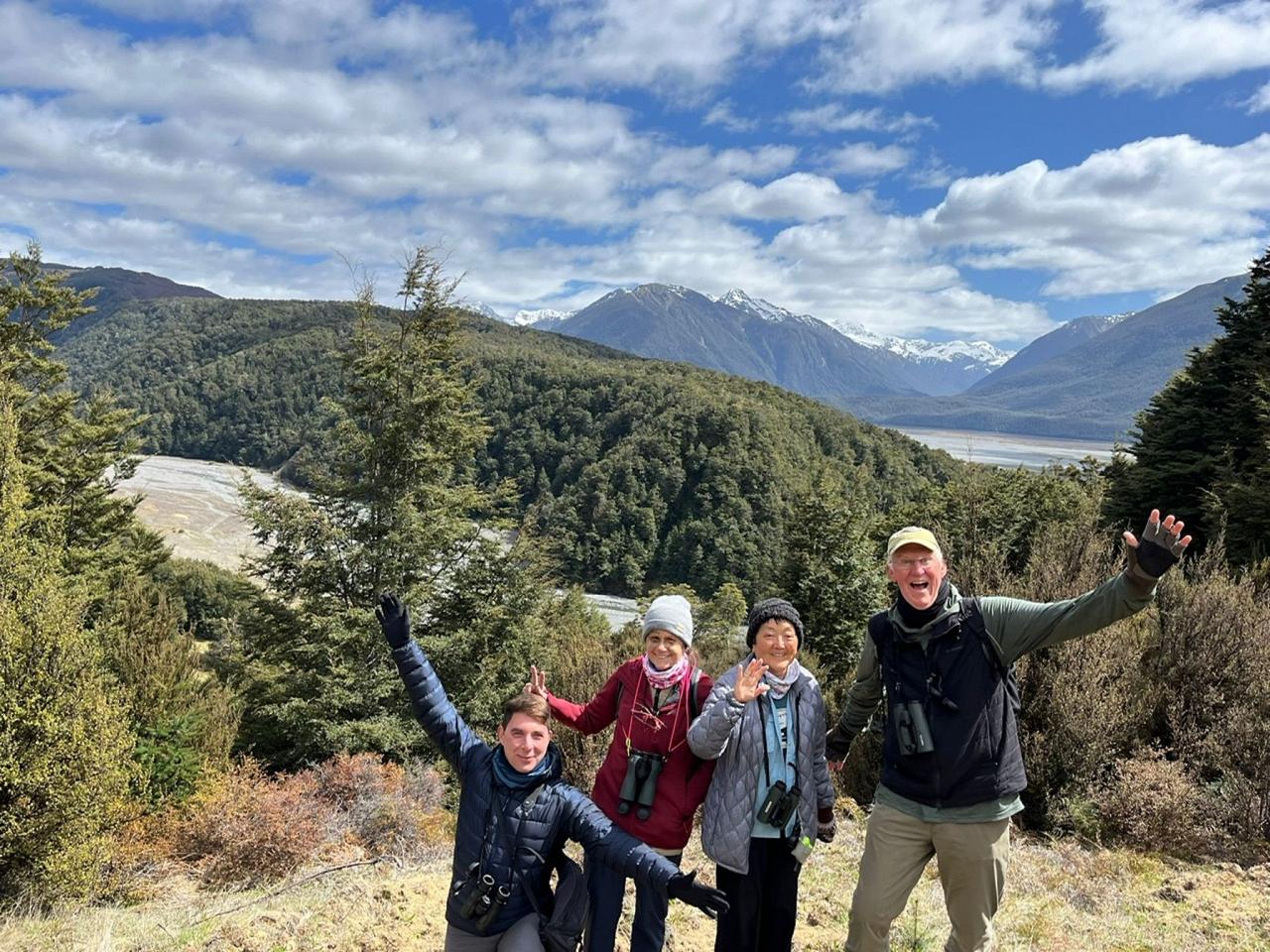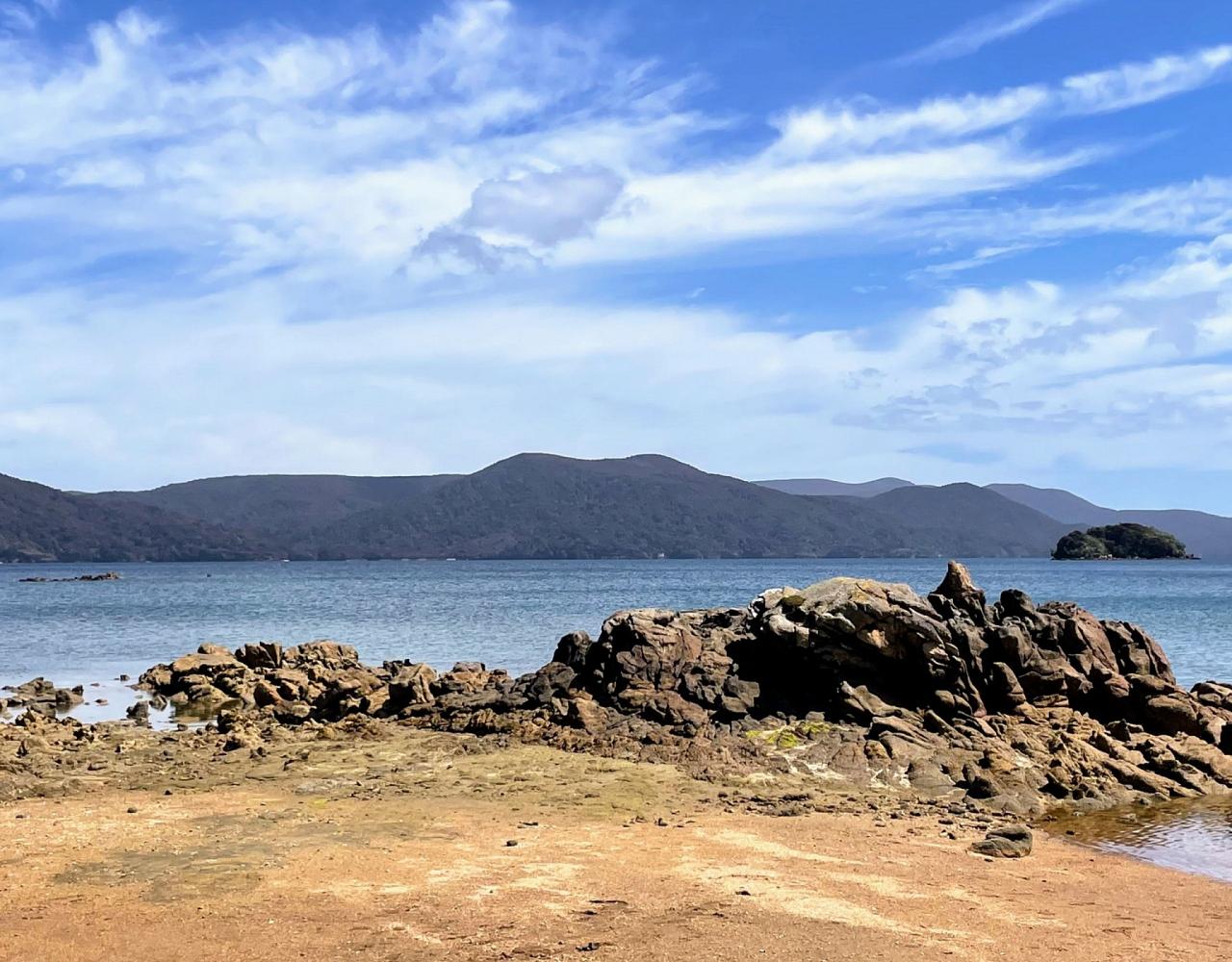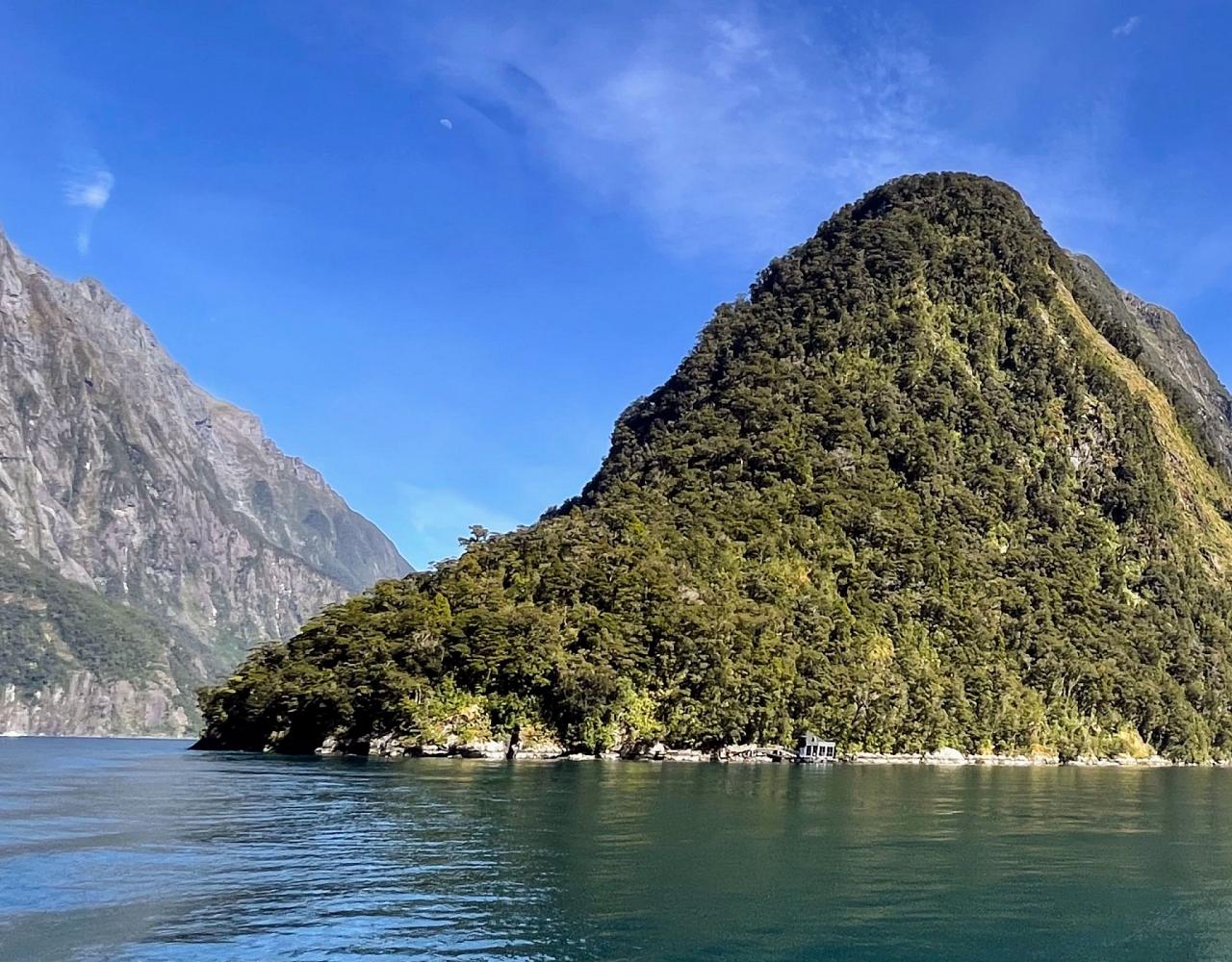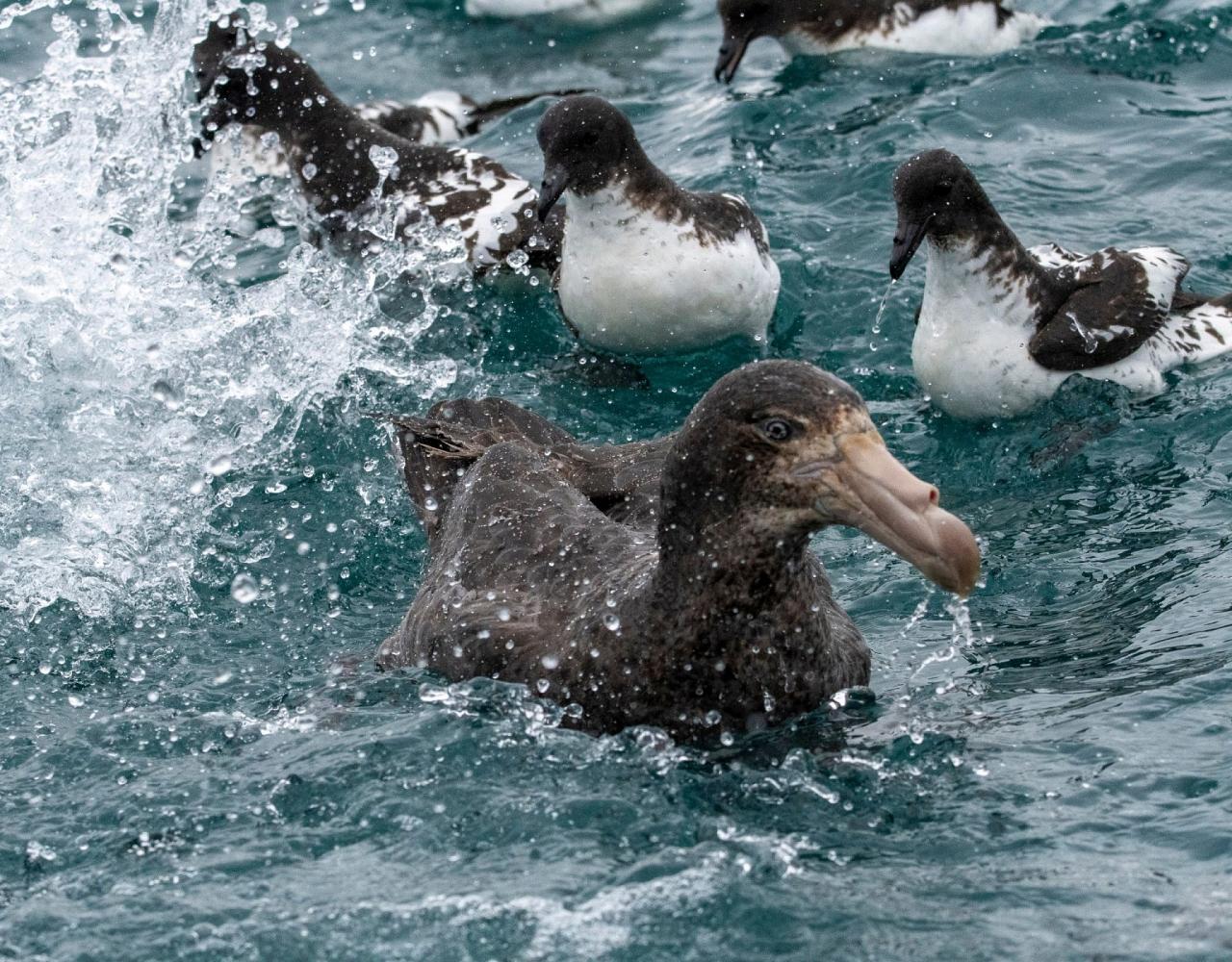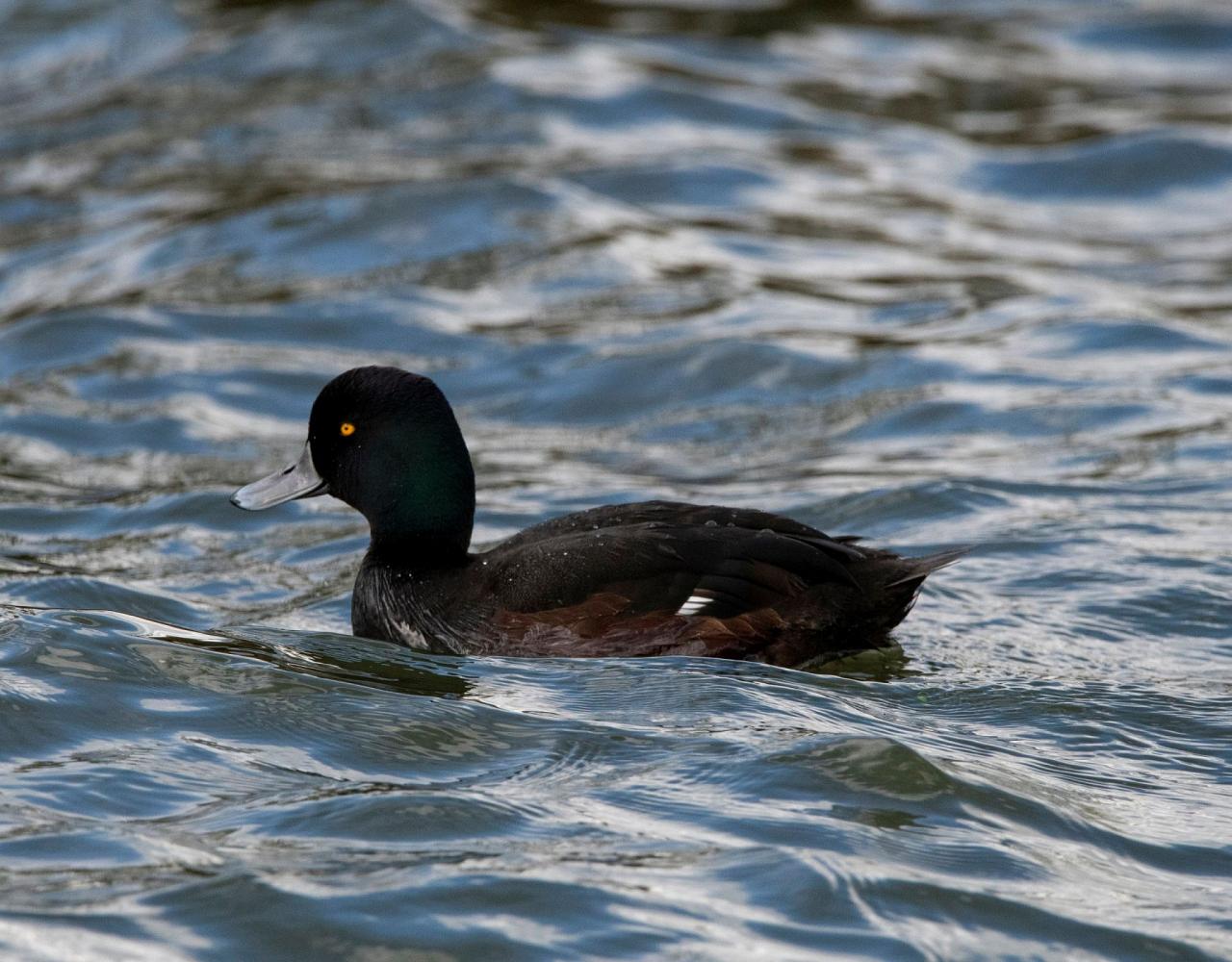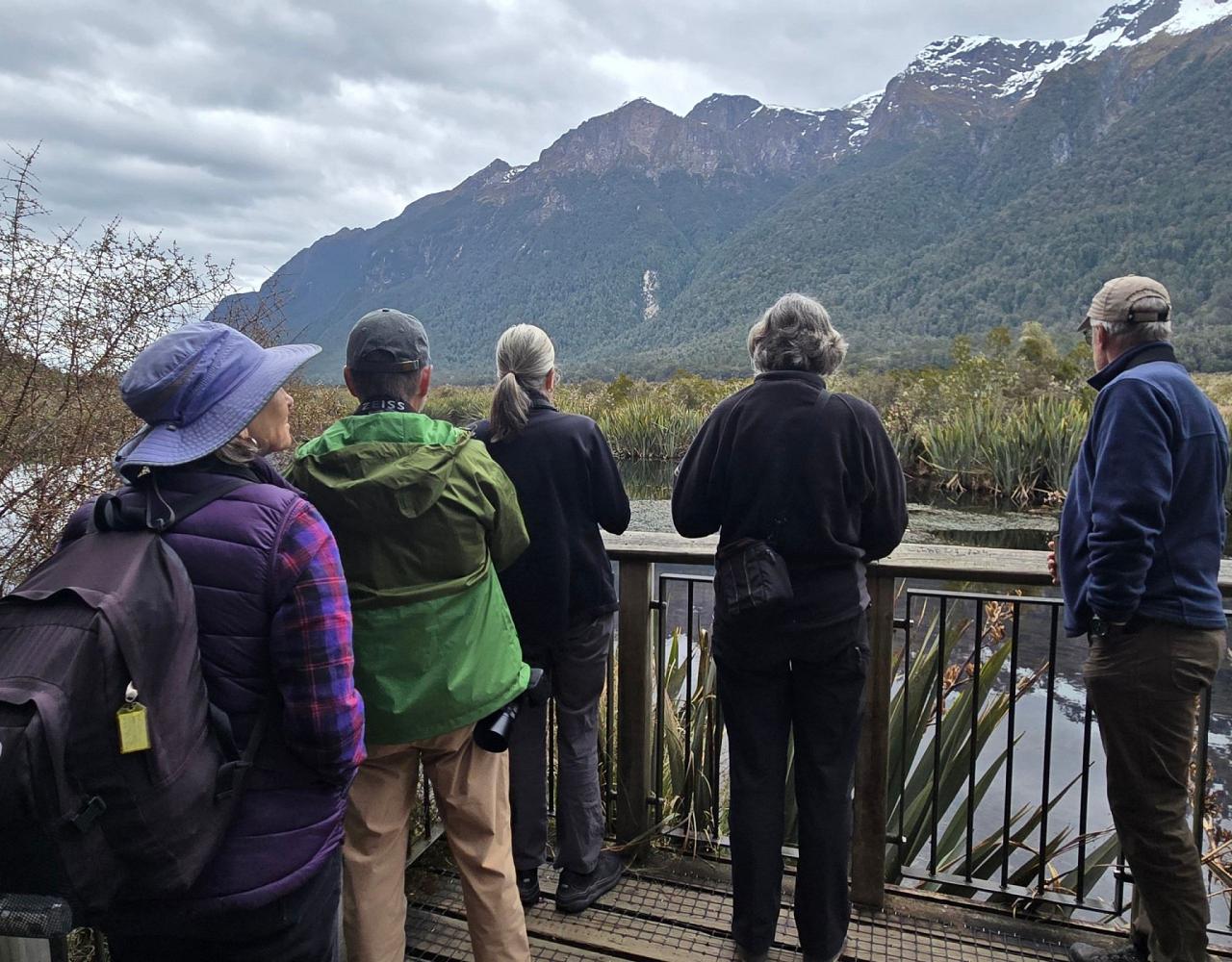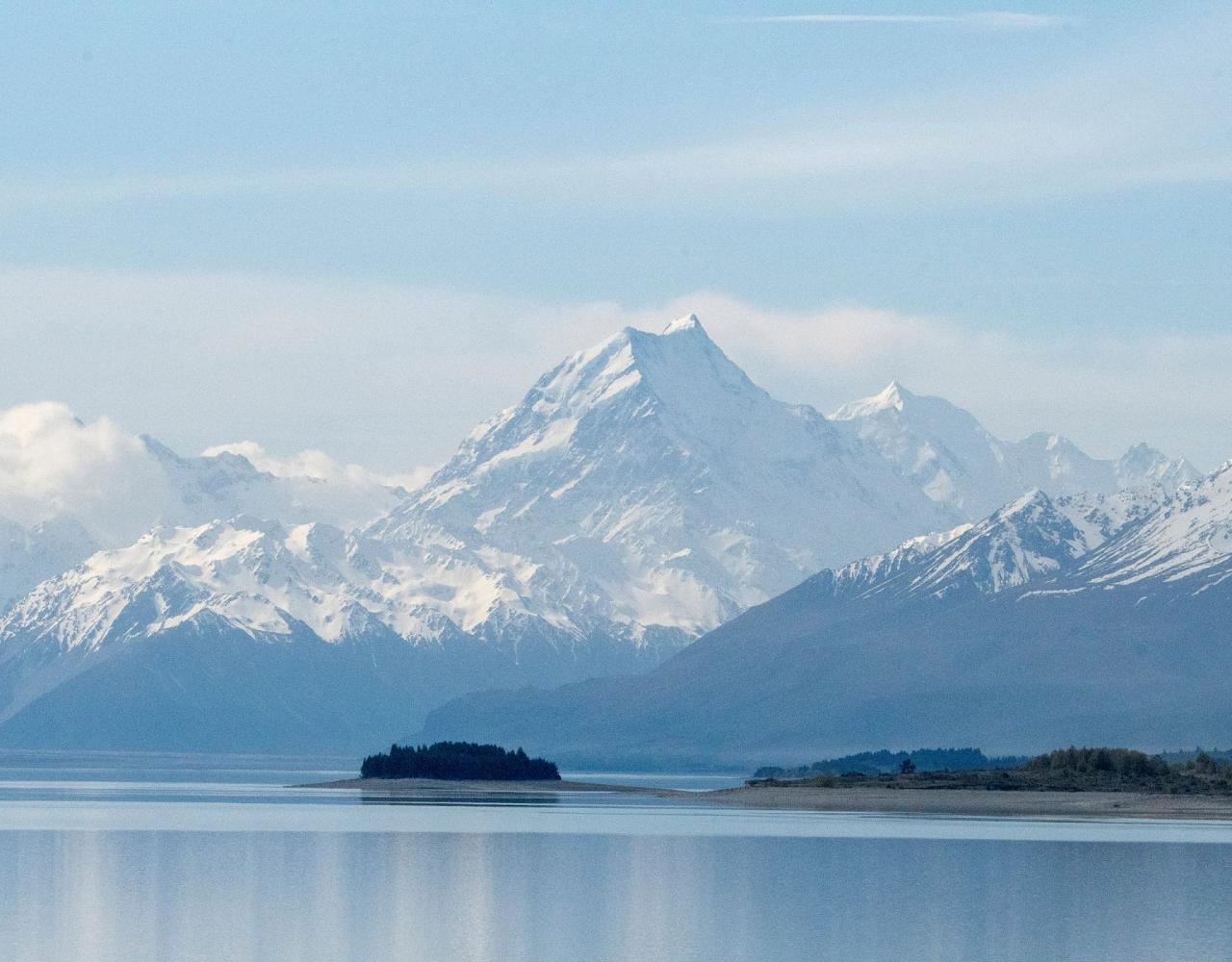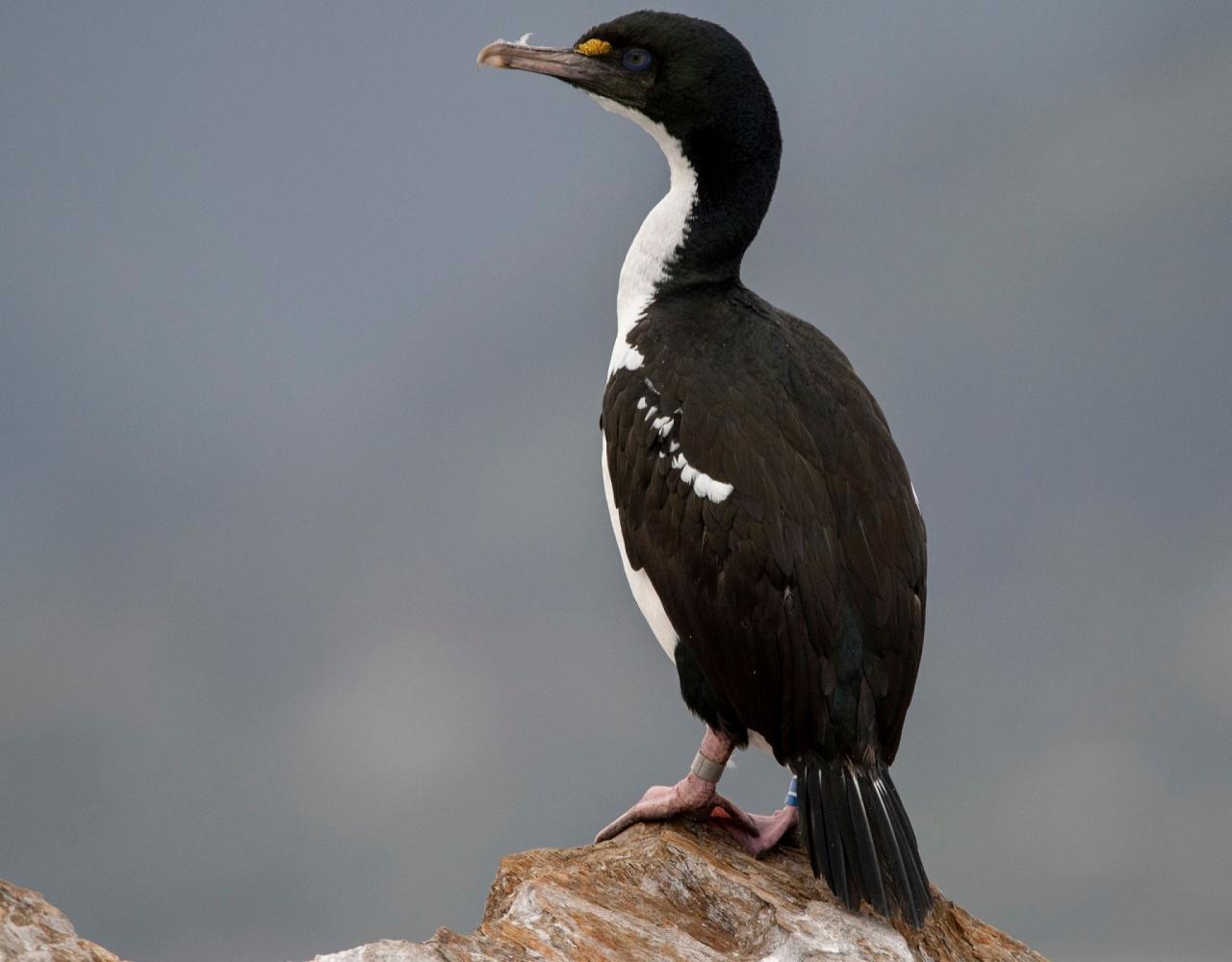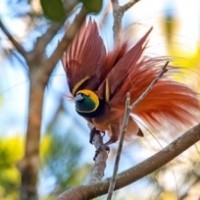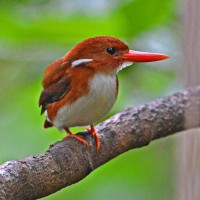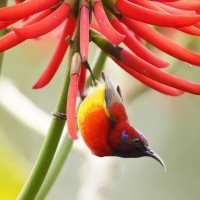Trip Itinerary
Itineraries are guidelines; variations in itinerary may occur to account for weather, road conditions, closures, etc. and to maximize your experience.
Wed., Jan. 7 Main Tour Begins – Welcome to Auckland!
Meet your Naturalist Journeys’ and our local partner company’s guide for lunch in central Auckland. Please take a taxi from the airport; they are readily available for the ride into the central city. After a lunch meet-up hosted by Naturalist Journeys, we head out for a sample adventure—if you are just arriving and tired from travel you can opt out as needed, but it is a beautiful place to start!
Auckland is an area characterized by water, volcanoes, and islands. We escape from the bustle of the city to enjoy a gentle introduction to the West Coast, and to watch Australasian Gannet soaring in towards their dotted rock outcrop colonies.
Stay at the Grand Millennium Hotel for two nights (L,D)
Thurs., Jan. 8 Tiritiri Matangi Island | Auckland
Tiritiri Matangi is an island sanctuary in the Hauraki Gulf, just north of Auckland. Many of New Zealand’s rare and endangered species now only remain on islands such as this, as the habitat can be protected from the ravages of rats, possums, and stoats. Tiritiri Matangi is the site of an ambitious restoration project started 17 years ago, and already the fruits of many people’s efforts are being appreciated by many. We have a day on this picturesque island to enjoy birdsong in regenerating forest, including that of re-introduced rare species such as the Saddleback, Stitchbird, Whitehead, and Red-crowned Parakeet. Also on the island are the unique Takahe and Brown Teal.
Sailing by ferry to the island Australasian Gannet, Black Petrel, Cook’s Petrel, and Buller’s Shearwater may pass us.
Dinner tonight is at leisure, and there are multiple places to choose from in walking distance from the hotel. Take the evening to rest up after a full day!
Return to the Grand Millennium Hotel (B,L)
Fri., Jan. 9 Depart Auckland | Miranda Wildlife Sanctuary (Shorebirds Galore!)
Within an hour’s drive southeast of Auckland lies Miranda Wildlife Sanctuary, a fine feeding ground for many wading birds, which migrate from the tundra of the arctic regions for the northern winter. Among the thousands of Bar-tailed Godwits on the shell banks or silt flats, we may view many Red Knots and South Island Pied Oystercatchers, the rare endemic Wrybill, the endangered New Zealand Dotterel, Far Eastern Curlew, Whimbrel, several Sandpipers, Caspian Tern, Little Tern, and Sacred Kingfisher.
Later this morning, we travel towards Lake Rotorua, where New Zealand Grebe, New Zealand Scaup, and Little Black Cormorant are often feeding or roosting. Rotorua is situated in the central plateau of the North Island, a region of much geothermal activity. We take a walk through the Waimangu Volcanic Valley, an unspoiled, protected area featuring the world's largest hot spring.
Stay Rydes Rotorua, Rotorua (B,L,D)
Sat., Jan. 10 Pureora Forest Park | Tongariro National Park
This morning we have a dawn start, to experience the haunting call of the endangered North Island Kokako in its natural, misty rainforest environment. Pureora Forest Park contains one of the finest areas of podocarp forest in the country, as well as a large variety of native invertebrates, like the curious Peripatus, and numerous birds. We will have most of today to gain more insight into the nature and conservation of this special forest, and to enjoy the sounds of the New Zealand Kaka, Yellow-crowned Parakeet, Tomtit, New Zealand Robin, Long-tailed Koel, New Zealand Falcon, Whitehead, and Grey Warbler.
Later, our day winds up in Tongariro National Park. On the rivers running off the volcanoes a small number of the endangered Whio, or Blue Duck survive. Today we shall also make a special trip to search for these birds.
Accommodations at Skotel, Whakapapa one night (B,L,D)
Sun., Jan. 11 Mt. Ruapehu, North Island | Ferry Crossing to South Island
Morning walk amongst sub-alpine forest and tussocklands on the slopes of Mt. Ruapehu, the North Island’s highest peak. A longer day today as we travel to Wellington and cross to the South Island. En route to Wellington we shall deviate to the Foxton Estuary with opportunities for Pacific Golden Plover, and Royal Spoonbill.
Our journey continues southwards through to Wellington, where we embark on an evening ferry crossing to the South Island. Three hours, however, is at times not enough for all the wildlife watching to be done! Wandering and White-capped Albatrosses often pass by, as do Northern Giant Petrels, Arctic Skuas, and many shearwaters. Towards the entrance to the Marlborough Sounds can often be seen Little Blue Penguins, Spotted Shags, and sometimes dolphins.
Purchase dinner tonight as we go as we are on inter-island ferry.
Accommodations at the Picton Beachcomber Hotel, Picton (B,L)
Mon., Jan. 12 Marlborough Sounds Boat Cruise
The waters and inlets of the Marlborough Sounds will be our playground this morning. The cruise vessel carries us through Queen Charlotte Sound to a small rocky islet, where a small colony of the rare King Shag breeds and roosts. There may also be an opportunity to listen for the endangered orange fronted parakeet on one of the sound’s predator free islands. Before returning to Picton, we land to introduce ourselves to the curious Weka.
Mid-afternoon sees us heading south down the east coast to Kaikoura, where we stay for two nights.
Accommodations at White Morph Inn, Kaikoura (B,L,D)
Tues., Jan. 13 Kaikoura Seabird Cruise
Kaikoura is a breath-taking place where snow-iced mountains reach down to a turquoise sea. The continental shelf drops abruptly very close to shore, resulting in upwellings of nutrients from the sea’s depths, attracting a rich and abundant marine life. An excellent opportunity for bird lovers and generalists alike is a seabird excursion, where one can see flocks of cawing albatrosses (4-5 species), and numerous petrels and shearwaters, just meters from the boat.
In the afternoon we are at leisure to stroll on Kaikoura Peninsula, or you may opt to go out for a second pelagic or join a whale watching excursion for Sperm Whales. Meals today are flexible as you choose your adventure for the day.
Accommodations at White Morph Inn, Kaikoura - Lunch and Dinner are at leisure in this delightful town (B)
Wed., Jan. 14 Canterbury Plains | Southern Alps
Depart Kaikoura and travel south to cross the Canterbury Plains. Now one of New Zealand's most intensive agricultural regions the plains run down from the foothills to the central Southern Alps. Nestled between two passes, Porter’s and Arthur’s, lies the Craigieburn Range and the renowned Castle Hill Basin. We walk amidst the limestone formations that make up this basin. Later our destination is the Arthur’s Pass Wilderness Lodge, set amidst a delightful mix of high-country beech forest and tussocklands, and a working sheep farm.
Accommodations at Arthur’s Pass Wilderness Lodge (B,L,D)
Thurs., Jan. 15 Arthur’s Pass Wilderness Lodge | Mountains & Lakes
We enjoy a day amidst the Mountain Beech Forests and braided rivers of the upper Waimakariri Valley. The Moa Forest discovery morning involves no driving from the Lodge for those who want a “no driving” morning. A relaxed and fascinating discovery of a “micro world” of riverbed, rock bluff, shrubland, beech forest plants and animals.
Lunch in the Mt Rolleston Restaurant. An afternoon guided excursion is available for this wishing to explore further the mountains and lakes near the lodge.
Accommodations at Arthur’s Pass Wilderness Lodge (B,L,D)
Fri., Jan. 16 Lake Tekapo | Mount Cook National Park | Mackenzie Country
Cross back onto the Canterbury Plains and head south over Burkes Pass. As we wind across the foothills, with snow-capped mountains in the background, we overlook the vivid turquoise waters of Lake Tekapo and other large glacial lakes. After some birding we continue on to the Mackenzie Country Hotel.
Accommodations at the Alps Apartments Motel, Twizel (B,L,D)
Sat., Jan. 17 Braided Rivers | Mount Cook National Park
The braided rivers in this region are the habitat of the endangered Black Stilt, and we look also for Double-banded Plover and a range of inland waterfowl. Later today we travel up the Aoraki (Mount Cook National Park). Walk amidst the alpine splendor, search for the rare New Zealand Falcon, and take further opportunities to look for Black Stilt and Wrybill on their breeding grounds.
Accommodations at the Alps Apartments Motel, Twizel (B,L,D)
Sun., Jan. 18 Central Otago | Ferry to Stewart Island | Brown Kiwi Outing
This morning we depart the arid Mackenzie Country for Invercargill. Late this afternoon we take the ferry across to Stewart Island, watching for seabirds as we go. Settle into our lodgings and do some local birding. Dinner is at the lodge. Plan on an evening trip to view Stewart Island Kiwi on one of our two evenings here.
Accommodations at South Seas Hotel next two nights (B,L,D)
Mon., Jan. 19 Paterson Inlet | South Pacific Seabirds
A day marine charter to Paterson Inlet and into the South Pacific invigorates us with opportunities to observe a rich diversity of seabirds. Among the bays of the inlet we scan for two very rare penguin species: the Yellow-eyed Penguin and the Fiordland Crested Penguin. Out at sea we may encounter several species of albatross, including White-capped, Black-browed and Buller’s, and the Southern Giant Petrel, Brown Skua, and Broad-billed Prion. We are also likely to come across large flocks of Sooty Shearwater, which breed nearby on the small outer islands. A treat awaits us on Ulva Island, a bird sanctuary rich in lush podocarp forest, and ringing with the songs of the New Zealand Kaka, Tui, New Zealand Bellbird, and the rare Red-crowned Parakeet. The Stewart Island Weka is also a popular resident.
Accommodations at South Seas Hotel (B,L,D)
Tues., Jan. 20 Fiordland National Park
Back on the mainland, we are enticed by the glacially sculptured mountains and valleys of Fiordland National Park. We enjoy the afternoon in the wonderful beech forests of the Eglinton Valley. This forest is home to Long-tailed Koel, Yellow-crowned Parakeet, Brown Creeper, and Mohua/Yellowhead and provides an excellent opportunity for final views of New Zealand forest birds. Today is a full field day with picnic or local lunch.
Dinner and checklist tally tonight are at our hotel.
Accommodations at the Distinction Luxmore Hotel, Te Anau (B,L,D)
Wed., Jan. 21 Milford Sound
After breakfast at the hotel, we head out for a day excursion to Milford Sound. A drive to the Hollyford Valley delights us with mountain scenery. In this valley we seek out some endemic species, including the ubiquitous and cheeky Kea, and the elusive Rock Wren. We have lunch along the way.
Mid-afternoon we hope for good weather and a tour highlight—a grand finale cruise on famous Milford Sound. We then return for dinner and our checklist tally.
Accommodations at the Distinction Luxmore Hotel, Te Anau (B,L,D)
Thurs., Jan. 22 Southeastern Coast | Dunedin | Harbor Cruise
Cross the southern South Island , arriving in Dunedin, New Zealand’s “wildlife capital”, in the early afternoon.
A charming harbor cruise will take us around Taiaroa Head, the only mainland breeding site of Northern Royal Albatross. With a wingspan of three meters, these seabirds are certainly impressive, soaring over cliffs dotted with nests of Spotted Shags and the rare Stewart Island Shags. Past rocky shelves of lounging fur seals we will sail, on our way back down the harbor towards the central city. Indeed, a magical wildlife experience, drawing to a close our rich and diverse discovery of New Zealand’s native treasures.
Accommodations in the Heritage Leisure Lodge, Dunedin. (B,L,D)
Fri., Jan. 23 Departures
While you can depart today at leisure, we suggest you book flights out in the afternoon, so we have a morning backup if weather precludes our harbor cruise the afternoon prior. This is up to you, but if it works for your outbound route, we suggest flights out after 3PM. We will make every effort to cruise the final afternoon, this morning is a weather backup. (B)
Essential Information +
This information is important for being prepared for your journey; we want you to have Read more
This information is important for being prepared for your journey; we want you to have the best experience possible. If you only read one section, this one is key!
Ahead of Your Tour
- Make sure your passport will be valid at least three months after the date of your scheduled return to the U.S..
- At the time of writing, all travelers to New Zealand need to complete and submit a New Zealand traveler declaration (NZTD) and receive a Traveller Pass at least 24 hours prior to departure.
- U.S. citizens traveling to or transiting through New Zealand under the visa waiver program are required to request a New Zealand Electronic Travel Authority (NZeTA). See "Passport, Visa & Documents" section below.
- Please check current CDC recommendations for travel to New Zealand and consult with your doctor about general travel vaccinations you should have as precaution for travel. See the “General Health and Inoculations” section below.
- Travel insurance in case of serious medical emergency is strongly recommended. Full health coverage and repatriation is available through Allianz Travel Insurance.
- Soft sided luggage/duffel bags are easiest for packing the vans. Pack essential medications in your carry-on luggage, as well as one day of clothing and optics in case of luggage delay.
Passports, Visas & Documents
Guidelines and regulations can change. It is always advisable to double-check the country’s documentation requirements 60-90 days ahead of traveling. Information for U.S. citizens can be found at: https://travel.state.gov/content/travel/en/international-travel/International-Travel-Country-Information-Pages/NewZealand.html. If you are from another country, please contact the New Zealand embassy website for guidelines.
Passport: You must have a passport that is in good condition and is valid for at least three months AFTER your scheduled return to the U.S. You should have at least one blank page per stamp. The blank pages need to say “Visas” at the top. Pages marked “Amendments and Endorsements” will not be accepted.
New Zealand Electronic Travel Authority (NZeTA)
- U.S. citizens traveling to or transiting through New Zealand under the visa waiver program will need to request a New Zealand Electronic Travel Authorization (NZeTA).
- It can take up to 72 hours to process an NZeTA so apply well in advance of your trip. The NZeTA is valid for multiple visits for up to two years.
- You will need to provide proof of your valid passport in the application.
- If your NZeTA application is denied, you will need to apply for a visa. Visit the Embassy of New Zealand website for the most current visa information.
New Zealand Traveler Declaration (NZTD)
- Travelers to New Zealand by air will be required to complete and submit a New Zealand Traveler Declaration (NZTD) and receive a Traveler Pass prior to departure.
- The NZTD collects and assesses a person’s travel-related information, such as passport details, contact details in New Zealand (if staying in multiple locations, use the first address you will be at in New Zealand), travel history from the last 30 days, flight details, information about what you are bringing into New Zealand, including checked-in luggage and carry-on bags, immigration status including your visa or NZeTA, if you need one.
- The NZeTD is an online system. Once you start your digital declaration, you will get an email with a reference number. You can use this to make any changes up until you reach passport control in New Zealand.
- Once you have submitted your declaration, you will receive an email that includes information on what you need to know to enter New Zealand, based on what you have told them.
- You will need to resubmit your declaration if you make any changes to it. You do not need to print anything out. Your New Zealand Traveller Declaration will automatically be checked when your passport is scanned at the eGate or by a border officer.
As a precaution for lost or misplaced documents you carry on your person during travel, we highly recommend you keep hard and digital backup copies on your phone (either photo or PDF scan), as well as a hard copy left with your emergency contact at home. The recommended important documents to copy include, but are not limited to; your passport ID page, travel visa, the front and back of your credit card(s), the airline barcode on your luggage. This will greatly expedite getting new ones if necessary – we hope everyone will always keep travel documents close so that losing them will not be an issue.
General Health & Inoculations Information – Be Prepared!
Health requirements for entry to any country can change. It is always advisable to double-check the country’s health requirements and recommendations 60-90 days ahead of traveling. A helpful website for planning is the Centers for Disease Control and Prevention (CDC) website for New Zealand or by phone (800) CDC-INFO or (800) 232-4636.
We will share your health information with your guide. This information will be kept confidential but is very important as we want to be best prepared in case of medical emergency.
Vaccinations: Bring copies of your current vaccination records with you. There are no required vaccinations to enter New Zealand, however, the CDC recommends that all travelers be up to date with routine as well as basic travel vaccinations before traveling to any destination. Consult with your doctor for recommendations at least 4- 6 weeks before departing on your trip as some vaccines may require more than one dose and time to become effective.
Prescriptions: It is a good idea to pack any meds you take regularly in your carry-on luggage. Bring an extra pair of glasses or contact lenses. Bring an adequate supply of any prescription medications you use, a copy of the prescription and a list of generic names of your medicines as “back-up” in case it is necessary to purchase drugs while abroad. You’ll want to keep medications in their original, labeled containers.
Allergies: To be prepared for environmental triggers to allergies or breathing difficulties, please bring your allergy and/or asthma medication(s). If you have severe allergies talk to your doctor about carrying an EPI pen and notify your guides. It is also recommended to carry with you an up-to-date record of known allergies, chronic medical problems and Medic Alerts so that, if necessary, emergency treatment can be carried out without endangering your health.
Common Ailments: We recommend that you bring a travel-sized first aid kit and a supply of standard over-the-counter medications for prevention or treatment of common ailments (such as diarrhea, constipation, stomach upset, cough, congestion, head or body aches, insect bites and sunburn); as well as ointments, moisturizer, sunscreen, oral rehydration salts, band-aids, moleskin for blisters, cotton swabs, nail clippers, and tweezers, etc.
Altitude illness: According to the CDC's website, day trips to high-elevation destinations less than 8000 ft. with an evening return to a lower elevation are much less stressful on the body, depending on the time provided for your body to adjust. However, overnights at high altitudes may have more adverse affects on your body and you should be informed about altitude illness and Acute Mountain Sickness (AMS) (see CDC's information for Altitude Illness). The most general symptoms are headache and occasionally fatigue and dizziness. You’ll want to take it easy, particularly at first. The likelihood of these symptoms can be reduced by resting, drinking plenty of water, avoiding alcohol, taking aspirin and optimize acclimatization by adjusting itineraries to avoid going “too high too fast." If you have worries about the altitude, ask your physician about medications (such as Diamox) that may be right for you.
New Zealand is a modern nation with excellent sanitation; travel poses few health concerns. Water is safe to drink. Bring a first aid kit and medications for common ailments. The internal parasite Giardia does occur in New Zealand, so do not be tempted to drink from wilderness streams.
Weather & Climate
Temperatures may vary throughout the areas you will be visiting (inland versus coast and for day and night excursions). Summer in New Zealand falls between December and February with warm to moderately hot temperatures, depending on location and longer daylight hours. Daytime temperatures in January may range from 68-77°F. Evening temps may go as low as upper 40s°F - low 60s°F. In summer, it rarely gets hot, however, occasionally the temperature can reach or exceed 95°F in January and February in the eastern part of both islands, while on the west coasts the records are about 86°F.
North Island: The northern region and its eastern coast is typically sunnier and drier than the southern half of New Zealand, but there can still be plenty of rain. Temperatures will gradually become cooler the further south you go.
South Island: The South Island has been known for its variable weather swings. The locals would say you could experience all four seasons in one day.
Visit https://www.climatestotravel.com for an overview. You may want to check your favorite weather information website for forcasts and predictions closer to your date of travel.
Annoyances & Hazards
Mosquitoes can be found in New Zealand, as well as biting sand flies in mountain and coastal environments. There are no snakes or dangerous animals, making outdoor activities safe for visitors. Bring insect repellent, and consider lightweight, long-sleeved clothing. The sun can be strong, so plan to protect yourself against it.
Food & Drinks
We stop at convenience stores for our rest stops while traveling, and lodges have potable water to fill up your water bottle. Beer and wine are readily available for purchase at hotels, and we can stop to purchase liquor if needed. We can also stop for snacks and supplies; your guide shops for picnic lunches en route. Sometimes it’s just fun to see what markets carry!
Packing, Clothing & Laundry
Please, pack light. We are serious about this – we move around a lot; you just do not need much to cope with tropical life! Please do not bring anything more than you must.
Pack using soft-sided luggage, if at all possible, as it is easier to organize van space. Label your luggage with ID tags inside and out. Please reconfirm your airline’s baggage weight and size restrictions about a week or so before departure.
TRAVEL TIP: Imagine NOT getting your suitcase. Wear your most important shoes for the field and have one day’s clothing change (including a change of underwear!). And please DO NOT pack any essential medications, or your vital optics, in your checked luggage!
Dress is comfortable and informal throughout the trip. While some people will change for dinner, it is usually just to a drier or cleaner version of what they wore during the day. Dressing in layers is the best way to be comfortable. Choose clothing you don’t mind getting dirty or muddy and things that are comfortable and easy to launder and dry out.
Laundry services are generally available, but easiest if we have several days in one location. There is a full, complimentary laundry facility with washers and dryers at the Wilderness Lodge at Arthur's Pass, conveniently half-way through our itinerary.
See “Packing List” tab for detailed information regarding this tour and further recommendations.
Spending Money
It is always wise to inform your bank about your travel plans to prevent potential card blocks or suspicions of fraud when making overseas card payments.
New Zealand uses the New Zealand dollar. For the current exchange rate, please refer to online converter tool like www.xe.com, or your bank. You will be able to change money after your arrival. Travelex, at airports, is a cost-effective source. It is advisable to take some of the money in smaller bills for local shopping. We advise you carry a mix of different types of payments, such as the cash, an ATM card, and a credit card. Make sure you know your ATM PIN number. You should also inform your bank and your credit card companies that you will be traveling outside the country to avoid a freeze on your account – many banks do this as a security measure when unexpected purchases are made. If you want to withdraw cash while in New Zealand, debit cards are more cost-effective thatn credit cards which can charge high fees. If you plan to exchange cash in country, bring large U.S. bill ($50 or $100) in good condition that will give you the better rate when exchanging to local currency.
People often ask how much spending money to bring. Part of the answer depends on how much you want to shop. Tempting souvenirs are endless, and most shops take VISA and MasterCard or American Express. You may also want to bring cash for drinks with dinner (if available) or smaller local purchases.
Also, a number of meals are on your own – you pay for these yourself (these meals are marked on your itinerary). In most cases you can choose from a variety of restaurants.
Cell Phones & Internet Service
Your guide is well connected and can help if any urgent communication need arises. However, it is highly recommended that you travel with a cell phone, if only as a precaution for the unfortunate occurrence of a medical emergency during an outing and needing swift accessibility to critical personal or medical contacts.
Please check with your wireless provider to see if your phone and service will work in your destination country. Options include activating international roaming, purchasing a local SIM card at the airport (newer phones may not accept SIM cards), or simply turning off cellular service and relying on Wi-Fi to make calls and access the internet.
If your phone can connect to Wi-Fi, you may be able to make voice and video calls free of charge. Please contact your cell phone provider for further details. Another option if you have access to Wi-Fi, is to use smartphone apps like Skype, WhatsApp, or Viber to send text messages, and make voice calls, or video calls. Many smartphones, tablets, or laptops come with one of these apps pre-installed or you can download for free. If bringing a laptop or tablet, get a good dustcover to protect it at all times.
Make sure if you do NOT want to use your cell phone that you turn off your cellular data. You could incur huge charges if you are not on Wi-Fi. Putting your phone in airplane mode if you mainly use it for photos will save the battery as well.
Please refrain from taking or making cell phone calls in the vehicles when traveling with other passengers, unless it appears to be an emergency. This disrupts other guests, plan on cell phone call use on your own time.
Electricity
The standard in New Zealand is 230 Volts at 50 Hertz. The power plugs and sockets are of Type I. If you travel to New Zealand with a device that does not accept 230 Volts at 50 Hertz, you will need a voltage converter. Depending on how much you plan to travel in the future, it may be worthwhile to get a combination voltage converter and plug adapter. More information can be found at www.power-plugs-sockets.com.
Time
New Zealand is on New Zealand Standard Time (GMT+12), with daylight savings time. Time in Auckland is 16 hours ahead of New York City. Check www.timeanddate.com before leaving home for your conversion.
Questions?
Please contact Naturalist Journeys by email at clientservices@naturalistjourneys.com or telephone at our office: (520) 558-1146 or toll free: (866) 900-1146 if you have any questions. Many thanks for traveling with us and we hope you enjoy your journey!
Pace & Protocols +
Pace of the Tour & What to Expect
You will receive a Schedule-at-a-Glance and list of Read more
Pace of the Tour & What to Expect
You will receive a Schedule-at-a-Glance and list of hotels (our eContact List) a few weeks before your departure. This will serve as an outline for each day and alert you to any recent changes made in the schedule or to our hotels, if needed.
Our journeys are set up to follow the rhythm of nature. Our focus is on birding and nature; we offer full, well-planned field days and often get up early for that magical time around dawn. We generally follow the published itinerary, but we stay flexible to the weather, wildlife opportunities and the interests of the group. Your guide will keep you apprised of the next day’s schedule at each evening meal, noting what to bring and what to prepare for. Questions and/or concerns are welcome.
The pace of our Naturalist Journeys tours is moderate; to fully participate you should be able to get in and out of vehicles several times a day, and walk 1-3 miles over uneven terrain. It is important to participate with a flexible attitude as adjustments may be made in our schedule to make the most of our time in the field or for other purposes at your guide's discretion. We are not a “listing” bird company that drills down on target species, but at times we do wait for those special species unique to the places we visit. During the day, we take time to stop for photos and for educational opportunities to learn about conservation projects, landscapes, and geology. We appreciate other taxa as well as birds, with mammals often the biggest draw but plants and butterflies are also very popular. Our clients often lend their own expertise to the mix.
We like to make meals a fun and memorable part of the experience, too. Breakfasts are often at hotels, and we carry snacks, fruit, and water in the vans each day. Lunches are a mix of picnics in the field (weather dependent) and a chance to dine with locals at small cafes and restaurants. For dinner, we pride ourselves in our homework to keep up with the best choices for dining, choosing restaurants with atmosphere that specialize in local foods. On occasion we keep dinner simple to go back out in the field for sunset wildlife viewing or night walks. In some remote locations, our choices are limited. If you are tired, room service for dinner may be an option you can choose.
Naturalist Journeys International Trips: Guide Role
Naturalist Journeys supports ecotourism and the development of excellent local guides. Once we know our international partners and guides well, we can send out small groups working directly with these trusted partners, adding a Naturalist Journeys guide to assist the local expert when we have a group of 6-7 or more. This helps us keep your costs down while retaining tour quality. The local guide is your main guide. You can expect your Naturalist Journeys guide to be well-researched and often they are experienced in the destination, but their role is not to be primary, it is to help to organize logistics, help you find birds, mammals, and interesting other species in the field, keep reports, help facilitate group interactions, and to keep the trip within Naturalist Journeys' style. Local guides live in the countries we travel to, know the destinations intimately, and are often the strongest force for conservation in their countries. They open many doors for us to have a rich experience.
Smoking
Smoking is not permitted in any vehicle or in any situation where the group is participating in an activity together, such as a vehicle excursion or a guided walk. Please respect all designated smoking areas at hotels and restaurants.
Transportation
As a courtesy to each other, we ask that all travelers please rotate seating. On international trips we may all be in one small bus, on some trips we are in vans, particularly the roomy Sprinter Vans when available. Some areas require us to be in smaller 4-wheel drive or safari vehicles. Rotation allows you to sit with different drivers and alternate front and back seating.
Photo Release & Sharing
We take many group photos and will share photos with the group. And after your tour, we will organize a chance to share photos via Dropbox or Google Photos. Please note that this is our policy and if you prefer to be excluded, we need to know ahead of your tour.
By registering for this tour, you agree to grant to Naturalist Journeys and its authorized representatives’ permission to record on photography film and/or video, pictures of my participation in the tour. You further agree that any or all of the material photographed may be used, in any form, as part of any future publications, brochure, or other printed materials used to promote Naturalist Journeys, and further that such use shall be without payment of fees, royalties, special credit or other compensation.
Travel Insurance
You are traveling in remote areas. Naturalist Journeys strongly recommends you have full medical and evacuation insurance from a company such as Allianz, for all international travel. If you do not have medical coverage or evacuation coverage on your existing travel insurance policy or for some reason elected not to take that out, we advise getting an evacuation plan with Global Rescue, World Nomads, Medjet, Allianz (they can do evacuation only) or a similar company. These plans are typically $300-$400 for a year for multiple destinations. This coverage may be a part of a larger Travel Insurance policy but can also be purchased on its own.
Questions?
Please contact Naturalist Journeys by email at clientservices@naturalistjourneys.com or telephone our office: (520) 558-1146 or toll free: (866) 900-1146 if you have any questions. Many thanks for traveling with us and we hope you enjoy your journey.
Packing List +
Please pack light!
Please reconfirm your airline’s baggage weight and size restrictions about a week or Read more
Please pack light!
Please reconfirm your airline’s baggage weight and size restrictions about a week or so before departure. Soft luggage is much easier for us to pack in vans than a more rigid hard sided piece, so if you have the choice, please use your soft luggage. Be sure to have your name and address on the inside of the bag, as well as on the luggage tag on the handle. It is our hope that you can pack in one checked bag that does not exceed 45 pounds. If lighter, all the better!
Carry-On: Be sure to pack your personal medications, binoculars, camera, and other essential items in your carry-on bag and your travel documentation and money in a document pouch on your person, NOT in your checked luggage. You will want a day pack for field trips, so this is an ideal carry-on.
Travel Tip: To be on the safe side in case of luggage delay, consider wearing your most important shoes for the field and have one change of clothing for the field in your carry-on (including a change of underwear)!
Pack clothing that is appropriate for the anticipated temperatures and conditions. See the "Weather & Climate" section under "Essential Information" for general seasonal climate info for the date of this tour. In addition, you may check your preferred weather app closer to departure to get a better idea of the weather to expect.
Dress is comfortable and informal throughout the trip. Dressing in layers is the best way to be comfortable. Lightweight long sleeve shirts and long pants make ideal field clothing as they are more protective from sun, vegetation, and pests. But by all means bring some shorts if you prefer to wear them. Also, choose clothing you don’t mind getting dirty or muddy and things that are loose-fitting, comfortable and easy to layer, launder and dry out. A lightweight and waterproof outer layer is essential as well as comfortable hiking footwear.
Treating your clothing to better protect you from insects: It is possible to purchase Permethrin spray (online or from REI) to treat your field clothing and socks before your departure. Another approach is to purchase field clothing permeated with insect repellent such as the Craghoppers Insect Shield collection.
Note on clothing colors: We recommend muted colors of tan, brown, khaki, grey or green, as they are spotted less easily than white or bright colors, though camouflage clothing is not recommended.
WE DO NOT RECOMMEND TRAVELING WITH PRECIOUS OR VALUABLE JEWELRY – don’t tempt anyone and don’t bring things you’d regret losing, and your mind will be at ease!
Clothing & Gear
- Long pants, 2 – 3 pairs (comfortable and loose fitting is best)
- Thicker pair of pants for cold nights
- Lightweight long underwear/ or fleece tights that can layer with rain pants
- Shorts or zip-off/convertible pants (optional)
- Lightweight long-sleeved shirts – 2 or 3
- T-shirts or equivalent, 3 - 4 (remember you may buy some souvenir tees along the way!)
- Personal underclothing and pajamas
- Socks (easy to hand wash and dry)
- Raincoat or poncho (great if this doubles as a windbreaker)
- Rain pants (HIGHLY RECOMMENDED)
- Comfortable evening clothes (clean field clothes are appropriate, but feel free to go dressier if you wish)
- Bathing suit (optional)
- Broad-brimmed hat
- Bandana
- Comfortable walking shoes (tennis shoes, etc.)
- Lightweight hiking boots (preferably waterproof with good ankle support and non-slip soles)
- Comfortable light shoes for evenings, travel days (Crocs work well or sandals)
- Warm jacket: fleece fabric is ideal, but a sweatshirt or sweater will do
- Wind/waterproof gloves – for night spotting
- Warm scarf
- Warm windproof hat – for night spotting
- Field vest (optional): a great source is Big Pockets
Equipment & Miscellaneous
- Photo identification (name should match your passport to avoid issues with confirming your identity)
- Airline tickets or E-ticket verification
- Passport, visa, travel insurance info, money & credit cards.
- A secure pouch to carry the items above on your person at all times (such as a secure, under-clothing document pouch)
- As a backup: copies of all the above (phone and/or paper) packed in a separate location than on your person, plus a set given to your emergency contact at home as a backup. For passport, copy of the ID and entry stamp pages.
- Small daypack to carry gear while hiking
- Cell phone and charger
- Binoculars
- Camera and charger/extra batteries, memory cards/film, lens cleaning supplies and instruction manual (optional)
- Spotting scope and tripod (optional – guide will have them)
- Tablet/laptop for personal use and/or transferring photos, USB stick, USB cord and charger (optional)
- Power plug adapter & electrical transformer (New Zealand uses a unique three-pronged plug on a 250v system)
- Small flashlight or headlamp with fresh batteries
- Alarm clock (or use your cell phone)
- Sunscreen/lip balm with high SPF
- Sunglasses with neck strap
- Insect repellent with DEET
- Toilet articles
- Personal water bottle (to refill during the journey – we do try to save on plastics!)
- Walking sticks if you use them regularly, collapsible poles work well
- Umbrella (optional)
- Notebook and pen or journal (optional)
- Field guides (optional)
- Earplugs (if hotel noise or roommates snoring may bother you; optional)
- Rechargeable power bank (optional)
- Hand-washing laundry kit: large zip-lock bag and/or sink stopper that stopper that fits all sizes, short piece of clothesline, and laundry soap (consider non-liquid laundry soap "sheets" that pack flat, and are lightweight and environmentally friendly).
- Washcloth (optional – not always provided in hotels)
- Travel sewing kit
- A collapsible airplane footrest (such as an inflatable, foldable, or hammock type) may help make longer flights more comfortable. Some airlines may have restrictions, so confirm with your airline which types are allowed and where they may be not allowed, i.e. bulkhead or exit rows (optional)
Medical & First Aid Items
- Heath insurance and vaccination records (kept in personal pouch with other travel documents)
- Personal prescription medications (and copy of vital prescriptions)
- Motion sickness preventatives if likely to be needed on bus, van drives, the ferry ride, etc.
- Personal first aid kit and over the counter medications for general ailments (Imodium or Lomotil, packed in their original packaging
- Antihistamine cream or tablets, eye drops, etc.)
- Copy of eyeglass prescription, medical prescriptions, and any medical alerts
- Extra pair of eyeglasses or contacts
- Band-aids, moleskin to protect against blisters
- Small bottle of hand sanitizer
Suggested Reading List +
There are many titles of interest for New Zealand. The following are a few that Read more
Useful Links +
Learn more about your destination at these external websites, carefully researched for you. Read more
General
New Zealand – Encyclopedic Overview
Auckland
Nature, Wildlife & Biology
Birding New Zealand
Ornithological Society of New Zealand
Birds A – Z – New Zealand
General Bird List, Including Extinct Birds
Endemic Birds
New Zealand Storm-Petrel – Critically Endangered
Birds of Prey - Be sure to read the “full story”
Flightless Birds
Tiritiri Matangi Island
Beech Forests of New Zealand
Milford Sound Wildlife
Native Animal Overview
A profile of the endemic Hector’s Dolphin - WWF
Nature and Wildlife Overview
Conservation, Parks & Reserves
New Zealand Bird Atlas Project Complete 2024
Mount Cook National Park
Miranda Wildlife Sanctuary
Department of Conservation: A great, all-encompassing website with plenty of general (but thorough) wildlife information; a great site to pique your curiosity on topics to google further
Kiwis for Kiwi
Geology & Geography
Geology of New Zealand - GNS Science
Mount Ruapehu
Canterbury Plains
Geography of Fiordland National Park
History & Culture
Pureora Forest Park
"20 years on, a transformed New Zealand looks back at 'Lord of the Rings'" - L.A. Times Article by Kevin Baxter
A summary of human history of New Zealand
New Zealand History – Covering a wide variety of topics from culture to politics and more
Helpful Travel Websites
National Passport Information Center
Homeland Security Real ID Act
U.S. Customs and Border Protection (CBP)
Transportation Security Administration (TSA)
Foreign Exchange Rates
ATM Locator
U.S. Department of State International Travel Information – New Zealand
Center for Disease Control (CDC) – New Zealand
Canada Travel Advice and Advisories – New Zealand
Travel Health Pro (UK) – New Zealand
Electricity and Plugs – New Zealand
Date, Time, and Holidays – New Zealand

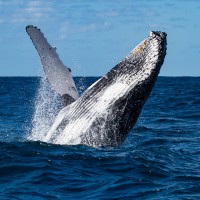 Southern California: Spring Coastal BirdingFebruary 16 - 23, 2026
Southern California: Spring Coastal BirdingFebruary 16 - 23, 2026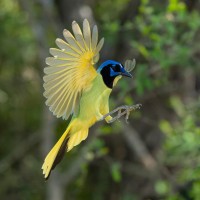 South Texas Birding & NatureMarch 11 - 19, 2026
South Texas Birding & NatureMarch 11 - 19, 2026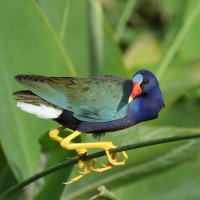 Texas Coast & Big Thicket A Legacy Club Journey for The Nature ConservancyApril 22 - 27, 2026
Texas Coast & Big Thicket A Legacy Club Journey for The Nature ConservancyApril 22 - 27, 2026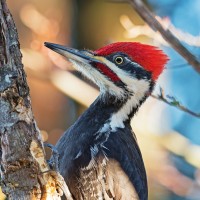 Oregon's Malheur NWR & Woodpecker WonderlandMay 18 - 27, 2026
Oregon's Malheur NWR & Woodpecker WonderlandMay 18 - 27, 2026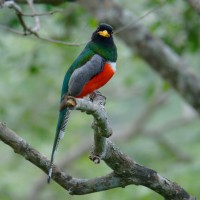 Arizona Monsoon Madness: Birding & Nature in a Season of Wonder!August 10 - 17, 2026
Arizona Monsoon Madness: Birding & Nature in a Season of Wonder!August 10 - 17, 2026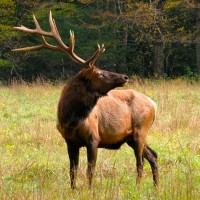 Yellowstone in The FallSeptember 19 - 25, 2026
Yellowstone in The FallSeptember 19 - 25, 2026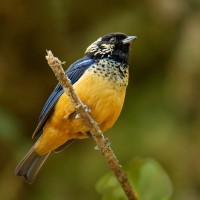 Western Panama: Tranquilo BayOctober 11 - 18, 2026, w/Mt. Totumas extension
Western Panama: Tranquilo BayOctober 11 - 18, 2026, w/Mt. Totumas extension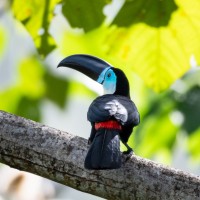 Thanksgiving in Trinidad & TobagoNovember 22 - December 1, 2026
Thanksgiving in Trinidad & TobagoNovember 22 - December 1, 2026


